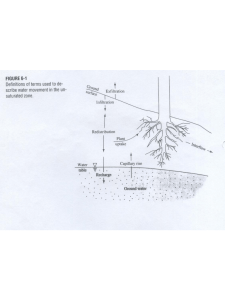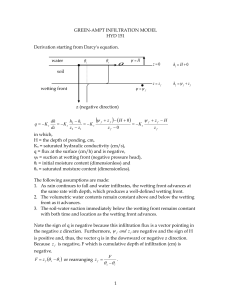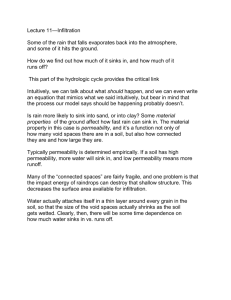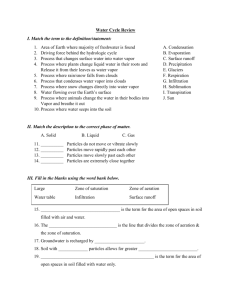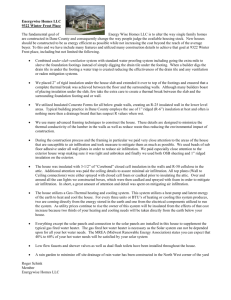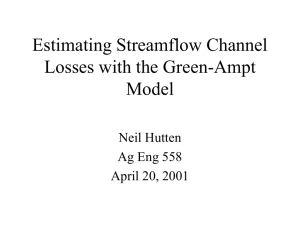Sharma revised proposal
advertisement
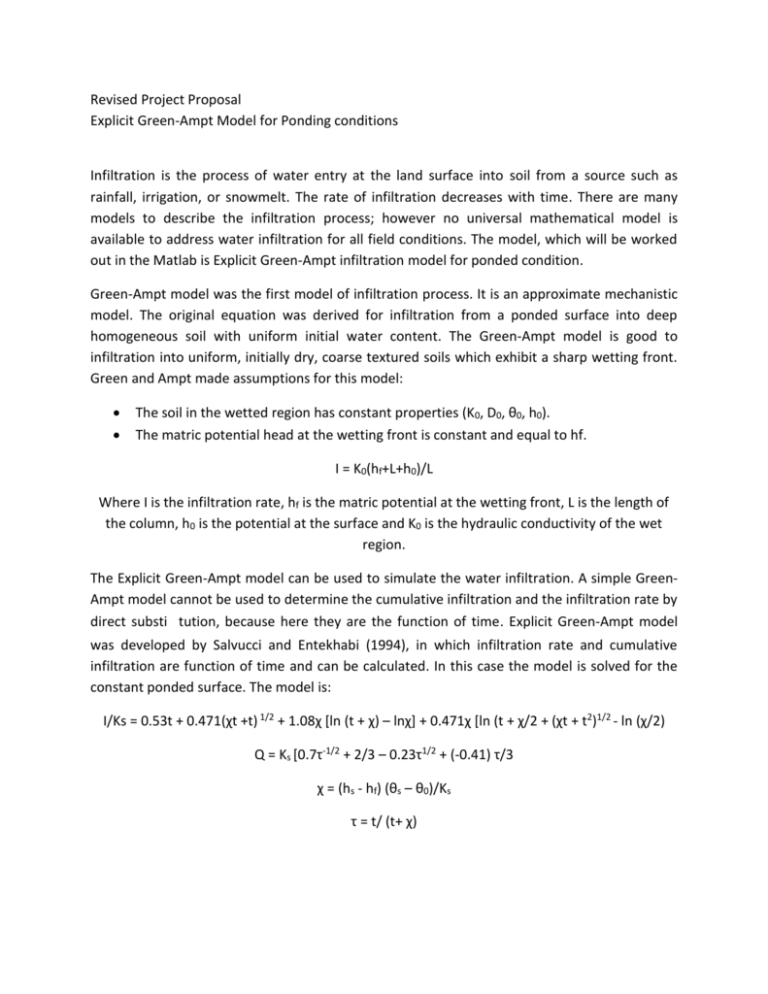
Revised Project Proposal Explicit Green-Ampt Model for Ponding conditions Infiltration is the process of water entry at the land surface into soil from a source such as rainfall, irrigation, or snowmelt. The rate of infiltration decreases with time. There are many models to describe the infiltration process; however no universal mathematical model is available to address water infiltration for all field conditions. The model, which will be worked out in the Matlab is Explicit Green-Ampt infiltration model for ponded condition. Green-Ampt model was the first model of infiltration process. It is an approximate mechanistic model. The original equation was derived for infiltration from a ponded surface into deep homogeneous soil with uniform initial water content. The Green-Ampt model is good to infiltration into uniform, initially dry, coarse textured soils which exhibit a sharp wetting front. Green and Ampt made assumptions for this model: The soil in the wetted region has constant properties (K0, D0, θ0, h0). The matric potential head at the wetting front is constant and equal to hf. I = K0(hf+L+h0)/L Where I is the infiltration rate, hf is the matric potential at the wetting front, L is the length of the column, h0 is the potential at the surface and K0 is the hydraulic conductivity of the wet region. The Explicit Green-Ampt model can be used to simulate the water infiltration. A simple GreenAmpt model cannot be used to determine the cumulative infiltration and the infiltration rate by direct substi tution, because here they are the function of time. Explicit Green-Ampt model was developed by Salvucci and Entekhabi (1994), in which infiltration rate and cumulative infiltration are function of time and can be calculated. In this case the model is solved for the constant ponded surface. The model is: I/Ks = 0.53t + 0.471(χt +t) 1/2 + 1.08χ [ln (t + χ) – lnχ] + 0.471χ [ln (t + χ/2 + (χt + t2)1/2 - ln (χ/2) Q = Ks [0.7τ-1/2 + 2/3 – 0.23τ1/2 + (-0.41) τ/3 χ = (hs - hf) (θs – θ0)/Ks τ = t/ (t+ χ) where Ks is the saturated hydraulic conductivity of the soil, θs is the water content at saturation, θ0 is the initial water content, r is the infiltration rate, I is the cumulative infiltration, h f is the soil water pressure head at the wetting surface. hf = η.he /(η-1) Where η = 2 + 3λ Where λ is Brook and Corey pore size distribution index which was used by Brakensien and Onstad to derive the hf and η relation, he is the air exit head. The conditions in this model are: The profile is a piston-type profile. There is constant and uniform initial water content (θi). The wetting front is very well defined such that the water content drops abruptly to the initial water content. The profile is homogeneous. There is no surface crust and sealing. This model is valid only for short term infiltration. The initial water content of the soil is assumed to be the residual water content, θr. A constant pressure head (hs) is maintained over the Soil Surface. The parameters required in this model would be Ks of the soil, θs, θ0, hf. This model would be on sandy soil. The parameters would be obtained from the study of Carsel and Parrish (1988). Carsel and Parrish obtained these parameters on the basis of soil texture. Reference: Williams R. Joseph, Ouyang Ying, Chen Jin-Song, Ravi Varadhan, Estimation of infiltration rate in vadose Zone: Application of selected mathematical models, Volume 2 , Infiltration, Handbook of Hydrology Turner R. Ellen, Comparison of Infiltration Equations and their validation with rainfall simulation Jury William, Horton Robert, Soil Physics, 6th edition, Submitted by: Sumit Sharma Response to the comments and questions: 1. The model is Explicit Green-Ampt model for ponding conditions. 2. Earlier the Idea was to compare the Horton and Green-Ampt Model, but due to incomplete information about parameters and data, the idea was discarded. Otherwise if the models were compared then one could compare the accuracy and applicability of the models or even compare the parameters. 3. This model is currently worked out in the software like Mathcad. 4. The parameters used for this model can be obtained from Brakensiek et al (1981), Carsel and Parrish (1988) and Panian (1987). 5. The reference* for this model is : a. Williams R. Joseph, Ouyang Ying, Chen Jin-Song, Ravi Varadhan, Estimation of infiltration rate in vadose Zone: Application of selected mathematical models, Volume 2 , b. Infiltration, Handbook of Hydrology c. Turner R. Ellen, Comparison of Infiltration Equations and their validation with rainfall simulation d. Jury William, Horton Robert, Soil Physics, 6th edition. *Some more references can be used in addition to the above references. Submitted by: Sumit Sharma



